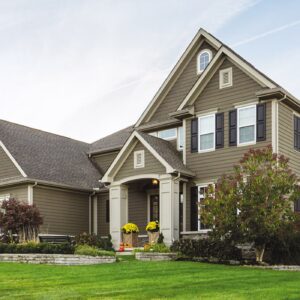If you’ve ever walked by your house and noticed that your siding is not lying flat, or has a wavy appearance, you may wonder what’s going on. Wavy and uneven siding isn’t uncommon, but it’s definitely not something you want to see happening. It’s mostly an occurrence that happens with vinyl siding thanks to its potential to warp and melt over time, especially if it was installed improperly. If you have wavy or uneven vinyl siding, don’t fret! I’m here to help. In this article, I’ll be diving into how you can fix wavy or uneven siding, and how to prevent it from happening again.
6 Reasons Your Siding Might Be Wavy or Uneven
- Improper Installation The most common cause of wavy siding is improper installation, especially the siding being nailed down too tightly. When the outside temperature changes, vinyl siding expands and contracts. And if it’s nailed down too tightly, it can’t move like it’s supposed to. This is what causes that wavy and uneven look. Not sure if your siding is nailed down too tightly? Try giving your siding a little wiggle by sliding the panels horizontally. If they move about half an inch, that’s good news – that means there’s room for it to expand and contract. If they don’t move, it’s likely being nailed too tightly is the cause of your issue.
- Nail PlacementWhen it comes to installing vinyl siding, one important thing to keep in mind are the oval-shaped openings at the top where it attaches to the structure. These openings are designed to allow the siding to expand and contract with temperature changes. It is crucial that the nails are placed in the center of these openings and not too close to either end. If the nails are too close to the end, it can cause the siding to warp and buckle, even if they are not driven all the way in
- Your Panels Aren’t Aligned Improper alignment of vinyl siding panels is another common installation mistake. If the ends of the panels are placed too close to trim around windows or corners, it doesn’t leave enough room for expansion and contraction, causing waving. If only a portion of your siding is wavy, this could be the issue. Keep in mind that these installation mistakes are common with DIY projects and can lead to costly repairs.
- Fluctuating TemperaturesTemperature fluctuations can cause natural expansion and contraction in vinyl siding, leading to a wavy appearance. This can be more pronounced in areas with extreme temperature changes, such as hot summers and cold winters. While this type of waving can’t be prevented, it’s important to keep in mind when you’re considering re-siding your home. Choosing materials that are better suited for the climate you live in can help reduce the visibility of this natural occurrence. Check out my recommendations for the best siding for homes in Maryland and Virginia.
- You Have Dark Siding Dark-colored siding can also contribute to warping. Darker hues tend to absorb more heat than lighter colors, so if you choose a darker shade, it could be causing warping due to the additional heat it attracts. If you recently painted your siding and didn’t notice any warping before, the color you chose could be the culprit.
- Poor Quality SidingIt’s important to ensure that the vinyl siding you choose is of good quality. Low-quality vinyl siding tends to be thin and less durable, and often comes with a slight wave to it even before installation. These imperfections will only worsen after installation and exposure to temperature changes. Investing in a higher quality, heat-resistant vinyl will help ensure that your siding maintains its shape for a longer period of time and withstands the elements better.
How Do I Fix Wavy and Uneven Siding?
Once your siding has started to warp, there is no way to straighten it out, but leaving the issue unresolved can lead to bigger problems. Warped or melted siding can leave your home’s structure exposed, allowing water to seep in and cause rot and mold. It also creates an inviting environment for insects.
The good news is if your siding has yet to start warping, but you’ve determined that the panels have been nailed down too tightly, you can loosen the nails without having to replace the siding. The not-so-great news is if the siding has already begun to wave or become uneven, it should be replaced as soon as possible to prevent any further issues.
So how do you prevent the issue of wavy or uneven siding from happening in the future?
How Can I Prevent Wavy Siding?
Vinyl siding is certainly durable, but it doesn’t come without its challenges. Here are some of my best tips to keep it in tip-top shape for as long as possible:
- Proper installation: Hire an expert contractor to ensure your vinyl siding is correctly installed, especially if you have unusual angles or uneven surfaces. This is the primary cause of wavy and uneven siding.
- Address small issues ASAP: Address small signs of warping immediately to avoid costly repairs in the future.
- Reduce sun damage: Landscaping, reflective shades, or materials that don’t melt (such as James Hardie Siding) can help diffuse sun damage and warping caused by modern energy-efficient windows.
- Choose fiber cement siding: Fiber cement siding doesn’t present the same challenges as vinyl, it doesn’t warp, requires minimal maintenance, and protects your home from the elements more thoroughly.
The Best Siding for Homes in Virginia & Maryland
Luckily, Maryland and Virginia’s climate is quite mild compared to other regions in the United States, however this does not mean it is not susceptible to harsh weather from time to time. For this reason, it is important you find the right siding material for your home. While vinyl siding is a good option for homes in Maryland and Virginia, if you’re worried about wavy siding, I’d recommend considering fiber cement siding as an alternative. Fiber cement siding is a great choice for a few reasons:
- It is versatile: Fiber cement siding comes in many textures. You can also carry out a color-matching test to ensure it suits the overall aesthetic of your home’s exterior.
- It is durable: Fiber cement siding is extremely durable and has a class 1A fire rating. It also does not easily warp or fade. Furthermore, it is highly resistant to inclement weather.
- It is cost-effective: Generally, fiber cement siding is less expensive than other siding materials like natural stone, cedar and wood siding.
- It is easy to maintain: Fiber cement siding is easy to maintain thanks to its durability. It can last for longer than fifty years when properly looked after.
Let WoW Help Fix Your Wavy Siding
Don’t let wavy or uneven siding ruin the look of your home. If you’re experiencing wavy siding, get in touch with Windows on Washington today. Our team of professionals have the knowledge and experience necessary to properly diagnose and repair any siding issues you may be experiencing. From proper installation to repairs and maintenance, we’ve got you covered. Give us a call today at 703-378-1190!



